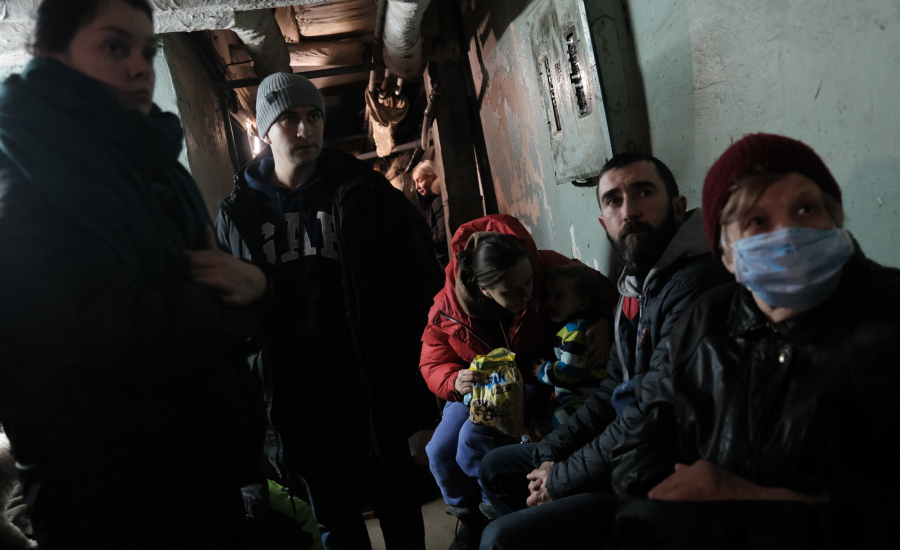How Do Civilians Respond to Political Violence?

Published by The Lawfare Institute
in Cooperation With

Editor’s Note: When conflict breaks out, civilians inevitably suffer. But they do not react uniformly, with some fleeing, others staying, and still others joining the fray. Aidan Milliff of Florida State University explains the different civilian responses, finding that civilians’ perceptions of their own agency often shape their behavior. He then discusses why the United States and other countries seeking to help civilians should focus more on changing their perceptions.
Daniel Byman
***
Last year alone, civilians around the world were exposed to over 125,000 instances of political violence. During Russia’s invasion of Ukraine and in ongoing civil wars and criminal conflicts in Syria, Sudan, Afghanistan, Mexico, Brazil, and other countries, millions of civilians have confronted impossible choices about what to do: Should they flee their homes and join the tens of millions displaced by conflict, should they hunker down and try to survive in place, or should they prepare to fight in an ad hoc militia to defend their homes and families?
How civilians make these life-or-death choices is an important question for policymakers who want to protect civilians during violence. It is also especially relevant today for military leaders who aim to uphold law of armed conflict obligations to civilians while planning and fighting wars.
A range of factors affect these individual decisions. Previous research has shown that people’s behavior during conflict is influenced at the margins by factors like the intensity of violence in their area, what kind of resources they have available to them, or whether they can rely on tight-knit local communities. My research shows that one very powerful, underappreciated determinant in people’s decisions is the way they perceive or interpret the violent environments they are facing.
Even people who are very similar to each other and facing very similar circumstances often interpret danger in different ways. Historical evidence from conflicts in India, as well as laboratory and survey experiments in Kenya and the United States, shows that two particular interpretations are especially important for understanding and predicting civilians’ behavior: a person’s interpretation of how much control they have over the outcome of a violent confrontation, and their interpretation of how unpredictable or uncertain the evolution of violent threats will be in the near future.
People who assess control and predictability differently typically pursue different behaviors when they are trying to survive political violence. People who feel uncertain about the future and believe they have no agency to mitigate threats to their safety are more likely to flee from violence, becoming internally displaced persons or refugees. Others who feel that they have some control over threats but aren’t confident in their ability to predict the future often try to fight back against threats, potentially by joining armed groups. And some people who feel that the future is more predictable and understandable either try to minimize their exposure to threats by “hiding” or try to engage constructively with the sources of danger, depending on how in control they feel.
The relationship between these perceptions of control and the predictability of future threats and civilian behavior helps explain the underperformance of U.S. attempts to stabilize conflict-affected states. By some measures, the U.S. government spends $6 billion per year attempting to stabilize conflict-affected states, plus more money to help individuals already displaced by ongoing conflicts. This spending takes a variety of forms, ranging from local infrastructure investments that were core to the “hearts and minds” counterinsurgency campaigns in Afghanistan and Iraq to larger-scale attempts at institution building and security sector reform.
Solid evidence shows that providing substantial resources can change civilian attitudes in the short run and that it is probably difficult to create peace and stability where conflict deprives people of essentials such as food security and health care. However, returns on stabilization spending in countries like Libya, Yemen, Syria, Iraq, Afghanistan, and Somalia (to name recent targets of U.S. stabilization assistance) have not been high.
Money, new school buildings, and food aid do not automatically make people feel more certain about the future of violence. Therefore, these resources do not automatically make civilians less likely to pursue destabilizing strategies like migration and participation in violence. For instance, development aid from Afghanistan’s National Solidarity Program, which ran from 2003 to 2011, was associated with stabilization and improved security in some Afghan provinces but not in others. Where the program worked, civilians had more positive perceptions of governance and security, but where the program produced no improvement, civilians’ perceptions were also unchanged.
The potential for disconnect between individuals’ perceptions and the on-the-ground reality helps explain why major investments in stabilization sometimes create only minor improvements. It also suggests that policymakers should, in the future, be less optimistic about the power of stabilization spending to change civilians’ minds about future uncertainty. The connection between the two isn’t always very strong or very consistent. Focusing programs exclusively on the “root causes” of conflict—material circumstances or security conditions—is tempting, but civilian stability outcomes might be better if policies focus more on increasing people’s perceptions that the future is predictable and that threats are manageable.
To change people’s assessment of threats and expectations about the future, policymakers need to experiment with new approaches to promote stability and civilian resilience. Experimenting with these policies is worth the effort because promoting civilian resilience-in-place during armed conflict is a valuable goal on humanitarian grounds and preempts the substantial policy challenges that come from mass displacement or escalating violence.
Alternative approaches should include strategies that provide early warning about violence or programs that provide longer-term guarantees of aid and investment, even if they are smaller in magnitude. This could discourage conflict escalation and risky migration behavior by helping people perceive the future as predictable and manageable. The same ethos of early warning and longer-term, lower-intensity guarantees could also be incorporated into operational planning for militaries, though the tactical trade-offs of foregoing surprise are worth considering.
This all suggests one more policy implication for protecting and supporting civilians who experience conflict: The tension between military and humanitarian imperatives during ongoing violence is even more substantial than is commonly appreciated. On the one hand, helping people feel more certain about the future trajectory of violence is potentially an important way to decrease escalatory and disruptive action by civilians trying to protect themselves. Changing perceptions of uncertainty may also be an important precondition for other stabilization efforts to work—attempts to materially improve civilians’ physical and economic security will create more stability when accompanied by changes in civilians’ expectations about future uncertainty. On the other hand, working to increase reassurance and early warning for civilians unavoidably works against tactical surprise for military operations. Surprising violence can be destabilizing and can increase uncertainty, whether or not it physically harms civilian bystanders. Negotiating the trade-off between surprise and uncertainty is especially difficult where armed actors are known to rely on civilians for information about their adversaries, hide among civilian populations, or depend on them for support.
Policymakers should devote more attention and resources to understanding the unavoidable (and often beneficial) processes of perception that shape civilians’ behavior during conflict. Focusing on the way civilians interpret conflict should lead to promising new avenues to promote stability and civilian well-being during violence.




